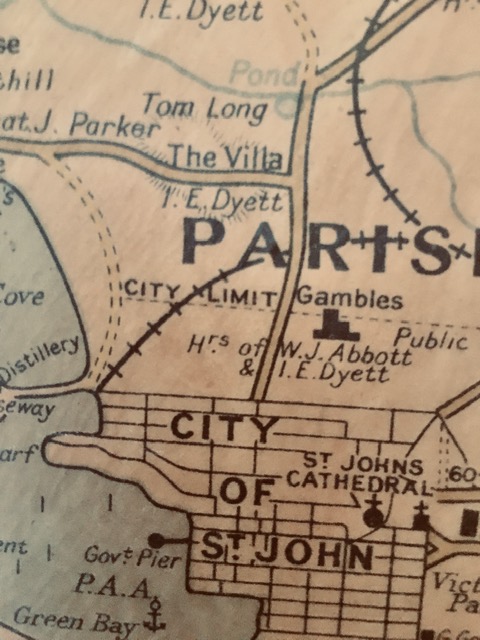About
Type: Ruin
Parish: St.John
Founding date: 1667
See on Google Maps!

Current Status
The estate house was beautifully situated on a knoll to the north of St. John’s with a charming view toward the west, overlooking St. John’s harbour and Fort James. The Villa Estate, combined with Gamble’s (#14), converted the sugar mill operations to steam around 1872. There is no mill left on this estate, nor any remnants of the old stone works or machinery.
This area was still considered a country until the 1950s. One of the locomotive lines crossed Fort Road at the location of the current Kentucky Fried Chicken fast food outlet. Even in the fifties, this was a residential area, which has become very commercialized with the encroachment of St. John’s.
Estate Related History/Timeline
Anne Lindsey (b. March 5, 1759), the only daughter of Earle Linsey Daniel, became the Attorney General of Dominica. Died in1806. Lord Baronet, or Viscount Combermere, was a title granted to Stapleton Cotton and his family of Combermere Abbey in England. Sir William Stapleton, the first Baronet, laid the foundations of the Stapleton lands and interest in the Leeward Islands, West Indies. At the time of his death in 1686, he had land interests on four islands. Stapleton Cotton manuscripts are held at Bangor University in England (Ref. GB 0222 STAP.)
With the abolishment of slavery by the British Parliament in 1833, the owner of the Villa, Philip Lyne Thomson, was paid £702. 5s. 2p. (Antigua 106) for granting freedom to 41 enslaved. An additional £1,241. 12s. 3p. (Antigua 107) was paid for the release of 81 enslaved, but records do not indicate the awardee.
1878: Lord, Baronet, or Viscount Combermere was a title given to Stapleton Cotton and his family of Combermere Abbey in England. Sir William Stapleton, the first Baronet (d. 1686), laid the foundation of the Stapleton lands and interests in the Leeward Islands, West Indies.
Stapleton Cotton manuscripts, held at Bangor University, Ref. GB0222 STAP.
“My mother used to visit Millie Este in the 1940s when she lived in the Buff house. In 1951 the old Buff house which was situated off Whapping Lane between Back Street and Alfred Peters street, was turned into the Rialto Club which provided a place for table tennis, warrie, dominoes and card games for young people. It was also in the Rialto Club that the famous debate on Christianity vs Islam took place in 1951 between Dean Baker, Arnold Chambers and Al Haji Talib Dawud. Islam prevailed that night.
Selvyn Walter, Not A Drum Was Heard.
“Tom Henry, one of the first ALP [Antigua Labour Party] founders, owned quite a bit of land near the old Buff house, known as Cassie Pasteur. Around 1951 he started selling lots in Cassie Pasteur.”
In the 1950s/1960s “The Villa Buff House as I knew it was on the hill behind Barrymore Hotel and a Mr. Fane last lived in the house. The estate
used to raise animals and Mr. Fane managed the property for Brysons which sold the meat. The house was demolished when Dr. Noel Margetson bought the property and built on the site around the late 50s, early 60s.”
Margaret White.
Dr. Margetson’s home (2010), beautifully constructed with Antigua green stone from the Liberta area, is now the site of the Winter Clinic, in near proximity to the Adelin Clinic. The Villa, as we know it today, is a village north of Dickenson Bay Street.
Enslaved People’s History
Based on contemporary research, we have little information to share about the enslaved peoples from this plantation at this time. With the abolishment of slavery by the British Parliament in 1833, the owner of the Villa, Philip Lyne Thomson, was paid £702. 5s. 2p. (Antigua 106) for granting freedom to 41 enslaved. An additional £1,241. 12s. 3p. (Antigua 107) was paid for the release of 81 enslaved, but records do not indicate the awardee. They probably had a maximum of 114 people working at that plantation. We will continue our quest for more information about these vital individuals.
Ownership Chronology
- 1667: The first mention of the name Morgan: Rice Morgan, was given a grant of 180 acres in Bermudian Valley on April 17, 1667, registered as a planter in 1672. Vere Oliver, Volume II
- 1722: Samuel Morgan Baptized in 1711
- 1742: William Lindsey d. 1748. 290 acres
- 1743: Jacob Morgan, who died this year: “I granted to Edward Chester and Peter Horgall my plantation of 216 acres in St. John’s Parish.”
- 1767: John Lindsey 231 acres, 114 slaves
- 1788: Thomas Daniel d. 1806. (1777/78 map by cartographer John Luffman.)
- 1790: Godschal Johnson, of London, and Samuel Eliot, “late of Antigua, now of Harley Street [London] for 5/- lease those two plantations called Morgan’s of 74 acres and Walkins of 93 acres, for one year.”
- 1806: Earle Lindsey Daniel Will: 1813
- 1811: William Lindsey Will: 1811. Sold two plantations in Antigua to Thomas Daniel. The plantations are not named in his will
- 1813: Earl Lindsay (sic) Daniel Will: July 9, 1813, forfeited his estate in Dominica “to pay encumbrances on my Villa Estate in Antigua.” He was a Lieutenant in the 12th Dragoons.
- 1820: T. Blackburn 1829: 290 acres, 42 slaves
- 1833: Philip Lyne Thompson
- 1851: Heirs of T. Blackburn
- 1878: Lord Combermere
- 1891: Lord Combermere & C. I. Thomas
- 1921: Colonel R. S. Cotton
- 1933: I. E. Dyett
- 1940’s: Millie Este or Brysons
- 1960’s: Dr. Noel Margetson. Site of the plantation house
- 2012: Winter Clinic on the buff house site